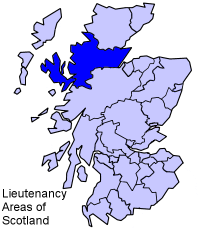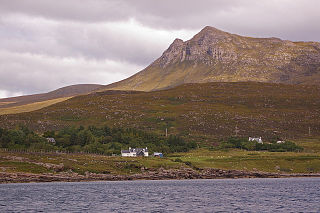
Clan Ross is a Highland Scottish clan. The original chiefs of the clan were the original Earls of Ross.

The shires of Scotland, or counties of Scotland, are historic subdivisions of Scotland established in the Middle Ages and used as administrative divisions until 1975. Originally established for judicial purposes, from the 17th century they started to be used for local administration purposes as well. The areas used for judicial functions (sheriffdoms) came to diverge from the shires, which ceased to be used for local government purposes after 1975 under the Local Government (Scotland) Act 1973.

Ross and Cromarty, sometimes referred to as Ross-shire and Cromartyshire, is a variously defined area in the Highlands and Islands of Scotland. There is a registration county and a lieutenancy area in current use, the latter of which is 8,019 square kilometres in extent. Historically there has also been a constituency of the Parliament of the United Kingdom, a local government county, a district of the Highland local government region and a management area of the Highland Council. The local government county is now divided between two local government areas: the Highland area and Na h-Eileanan Siar. Ross and Cromarty border Sutherland to the north and Inverness-shire to the south.

Earl of Cromartie is a title that has been created twice, both for members of the Mackenzie family. It was first created as Earl of Cromarty in the Peerage of Scotland in 1703 for Sir George Mackenzie, 2nd Baronet, but his titles were forfeited after the Jacobite rising of 1745. It was recreated in 1861 in the Peerage of the United Kingdom for Anne Sutherland-Leveson-Gower, Duchess of Sutherland. Since 1979, the Earl of Cromartie has been chief of Clan Mackenzie.

Skye and Lochalsh is one of eight former local government districts of the two-tier Highland region of Scotland. The main offices of the Skye and Lochalsh district council were in Portree, on the Isle of Skye.
The Lord-Lieutenant of Inverness is the British monarch's personal representative in an area which has been defined since 1975 as consisting of the local government districts of Inverness, Badenoch and Strathspey, and Lochaber, in Scotland, and this definition was renewed by the Lord-Lieutenants (Scotland) Order 1996. The area of the lieutenancy used to be the county of Inverness, which was abolished as a local government area by Local Government (Scotland) Act 1973. The districts were created, by the 1973 act, as districts of the two-tier Highland region and abolished as local government areas under the Local Government etc. (Scotland) Act 1994, which turned the Highland region into a unitary council area.
The Lord Lieutenant of Nairn, is the British monarch's personal representative in an area which has been defined since 1975 as consisting of the local government district of Nairn, in Scotland, and this definition was renewed by the Lord-Lieutenants (Scotland) Order 1996. Previously, the area of the lieutenancy was the county of Nairn, which was abolished as a local government area by the Local Government (Scotland) Act 1973. The district was created, under the 1973 act, with the boundaries of the county, as a district of the two-tier Highland region and abolished as a local government area under the Local Government (Scotland) Act 1994, which turned the Highland region into a unitary council area.
The Lord Lieutenant of Caithness is the British monarch's personal representative in an area defined since 1975 as consisting of the local government district of Caithness, in Scotland. This definition was renewed by the Lord-Lieutenants (Scotland) Order 1996. Previously, the area of the lieutenancy was the county of Caithness, which was abolished as a local government area by the Local Government (Scotland) Act 1973. The district was created under the 1973 act as a district of the two-tier Highland region and abolished as a local government area under the Local Government (Scotland) Act 1994, which turned the Highland region into a unitary council area.

Coigach is a peninsula north of Ullapool, in Wester Ross in the Northwest Highlands of Scotland. The area consists of a traditional crofting and fishing community of a couple of hundred houses located between mountain and shore on a peninsula looking over the Summer Isles and the sea. The main settlement is Achiltibuie. Like its northerly neighbour, Assynt in Sutherland, Coigach has mountains which rise sharply from quiet, lochan-studded moorland, and a highly indented rocky coast with many islands, bays and headlands. The highest summit is Ben Mor Coigach at 743 metres; the distinctive profile of Stac Pollaidh is the other main peak within Coigach. The scenic qualities of Coigach, along with neighbouring Assynt, have led to the area being designated as the Assynt-Coigach National Scenic Area, one of 40 such areas in Scotland.
Sir John Stirling, KT, MBE, TD was a Scottish soldier and politician.
Colonel Sir Hector Munro was a Scottish chief and military officer. He was the 32nd Chief of the Scottish Highland Clan Munro, 29th Baron and 11th Baronet of Foulis.
This is a list of people who have served as Lord Lieutenant of Ross-shire. The office was replaced by the Lord Lieutenant of Ross and Cromarty in 1891 through the operation of the Local Government (Scotland) Act 1889.
Sir Alexander Matheson, 1st Baronet MP JP DL, China merchant, Liberal Member of Parliament, and railway entrepreneur.
Sir Hector Munro, 1st Baronet of Foulis was a Scottish soldier, noble and clan chief of the highland Clan Munro. He is also by tradition the 19th Baron and 22nd overall chief of the clan. He is however the 12th chief of the Clan Munro who can be proved by contemporary evidence.

Clan Munro is a Highland Scottish clan. Historically the clan was based in Easter Ross in the Scottish Highlands. Traditional origins of the clan give its founder as Donald Munro who came from the north of Ireland and settled in Scotland in the eleventh century, though its true founder may have lived much later. It is also a strong tradition that the Munro chiefs supported Robert the Bruce during the Wars of Scottish Independence. The first proven clan chief on record however is Robert de Munro who died in 1369; his father is mentioned but not named in a number of charters. The clan chiefs originally held land principally at Findon on the Black Isle but exchanged it in 1350 for Estirfowlys. Robert's son Hugh who died in 1425 was the first of the family to be styled "of Foulis", despite which clan genealogies describe him as 9th baron.
Sir Kenneth Smith Mackenzie, 6th Baronet was a British diplomat, landowner and Lord Lieutenant of Ross and Cromarty 1881-1899.
The Sheriff of Ross, Cromarty and Sutherland was historically the office responsible for enforcing law and order in Ross-shire, Cromarty and Sutherland, Scotland and bringing criminals to justice.
The Sheriff of Inverness was historically the office responsible for enforcing law and order and bringing criminals to justice in Inverness, Scotland. Prior to 1748 most sheriffdoms were held on a hereditary basis. From that date, following the Jacobite uprising of 1745, the hereditary sheriffs were replaced by salaried sheriff-deputes, qualified advocates who were members of the Scottish Bar.
The Sheriff of Caithness was historically the royal official responsible for enforcing law and order in Caithness, Scotland.
Sir Hector Mackenzie, 4th Baronet of Gairloch was a Scottish landowner and baronet. He succeeded his father Sir Alexander on 13 April 1770. He held the office of Lord-Lieutenant of Ross-shire.